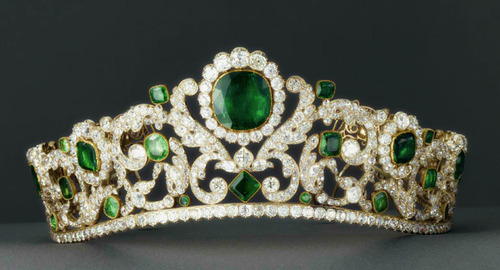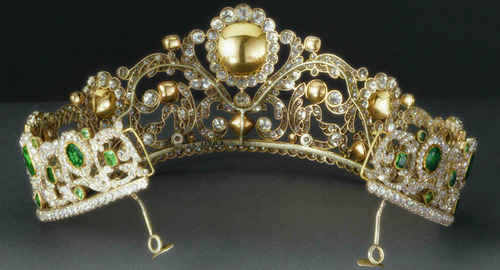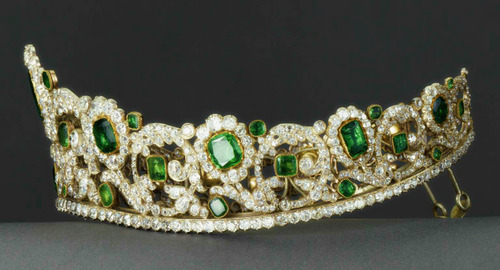sartorialadventure:Duchess of Angouleme’s emerald tiaraThe Duchess’ emerald tiara, a gift from her h
sartorialadventure:Duchess of Angouleme’s emerald tiaraThe Duchess’ emerald tiara, a gift from her husband Louis Antoine, Duke of Angoulême, was made in 1819-1820 by Evrard and Frederic Bapst and was designed specifically to use unmounted stones from the crown jewels. There are 40 emeralds in total, all set in gold and totaling about 77 carats all together; 14 of those were the largest emeralds available from the crown stash and the rest were added to match. They were joined by 1,031 diamonds (176 carats in all) set in silver. The diamonds, all set on a curved base, form a pattern of scrolling foliage which surround and incorporate the various shapes of emeralds available.Though made for the Duchess, the tiara was part of the crown jewels and was not her personal property. Before she departed for exile in 1830, following the abdication of her father-in-law Charles X and (20 minutes later) the abdication of her own husband from the French throne, she returned the tiara to the treasury. It remained a part of the French crown jewels through various changes of power; in particular, it was said to have been a favorite of Empress Eugénie, who had a special preference for emeralds and used the tiara during the reign of her husband Napoleon III (1853-1870). Along with the rest of the crown jewels, it was displayed at the third Paris World’s Fair in 1878 and at the Louvre in 1884. In 1887, it was sold at auction by the Third Republic along with most of the crown collection.Following the sale, the tiara made its way to Britain, where it surfaces in the 1960s in storage in the vaults of Wartski - where, according to Geoffrey Munn, managing director of Wartski and author of Tiaras: A History of Splendour, it was simply an emerald and diamond tiara, stored without knowledge of its provenance. Once its historical significance was uncovered, it was allowed to be displayed at London’s Victoria & Albert Museum from 1982-2002. In 2002, the tiara’s anonymous British owner decided it was time to sell. When the tiara went up for sale, the British government interfered and placed a temporary export ban on the diadem to give someone in Britain the opportunity to raise the required funds and keep it in the country. The export ban expired without a successful British purchase. A happy ending was in store, though: the Louvre was able to negotiate a successful agreement and acquired the tiara for their collection. The diadem returned home to France, where it joins other re-acquired items from the French crown jewels on public display. -- source link
Tumblr Blog : sartorialadventure.tumblr.com


